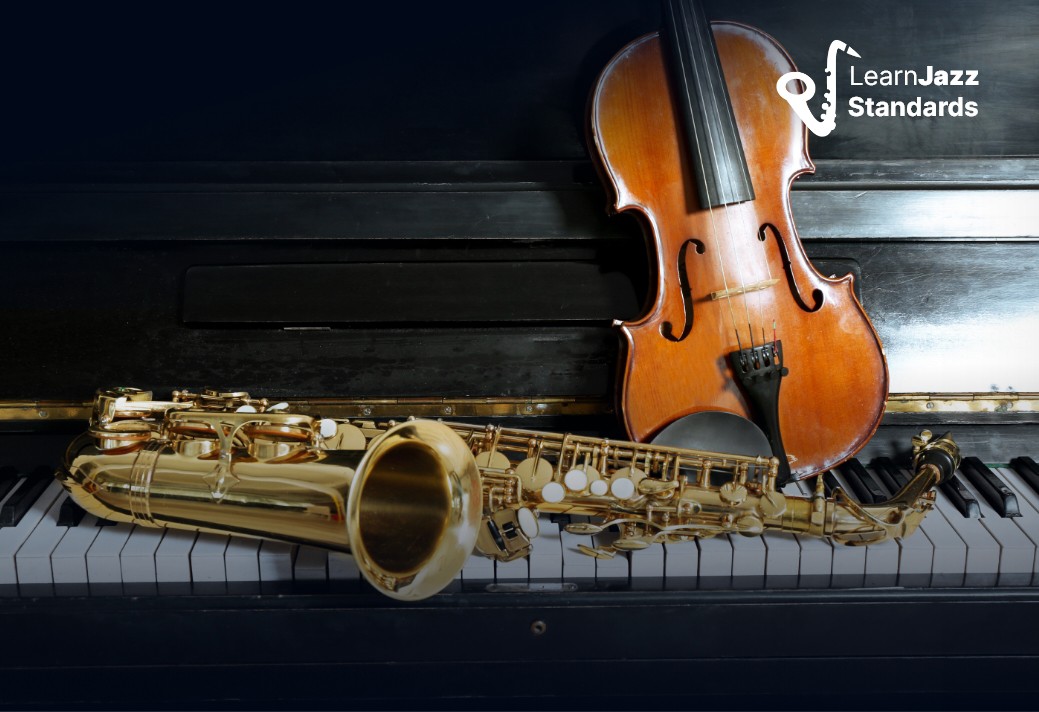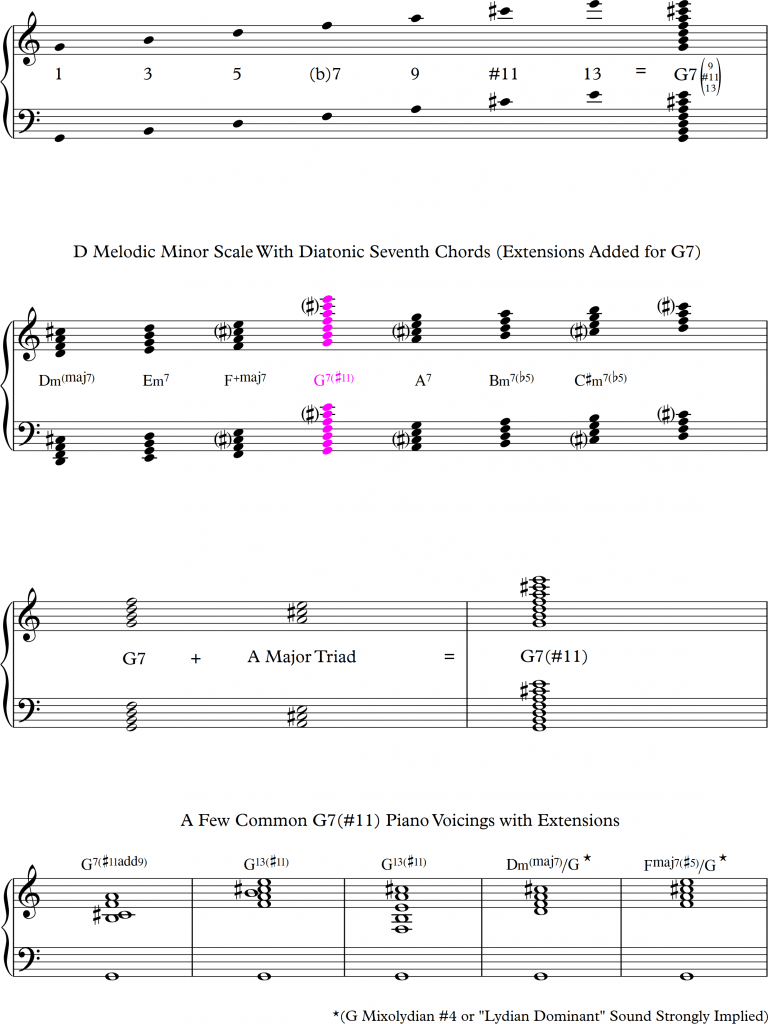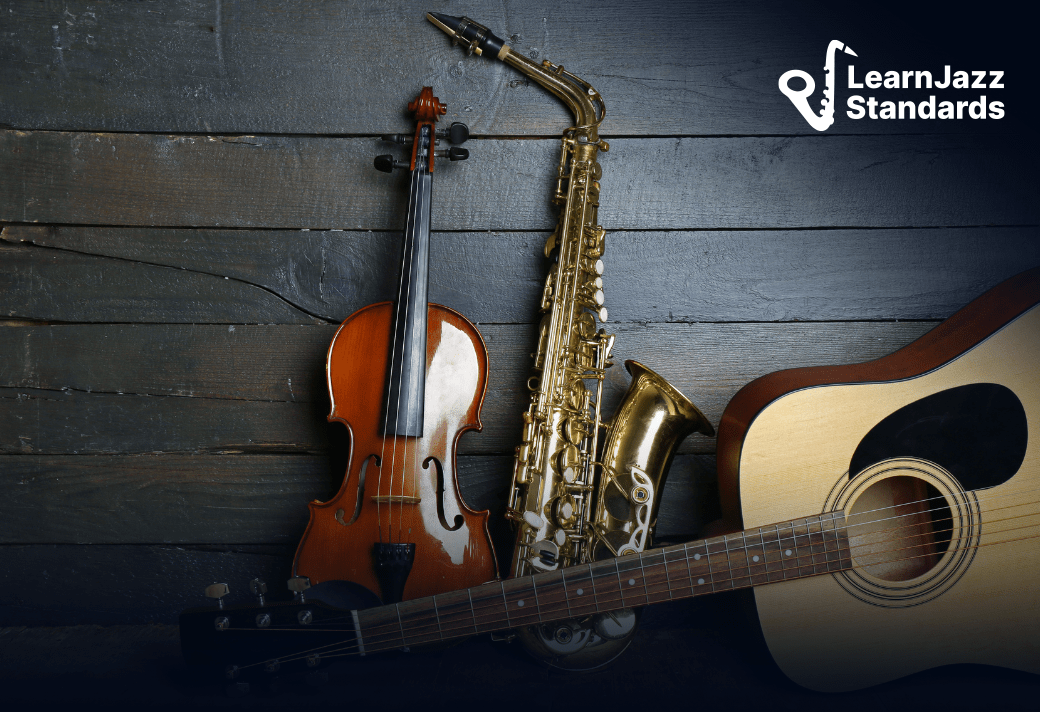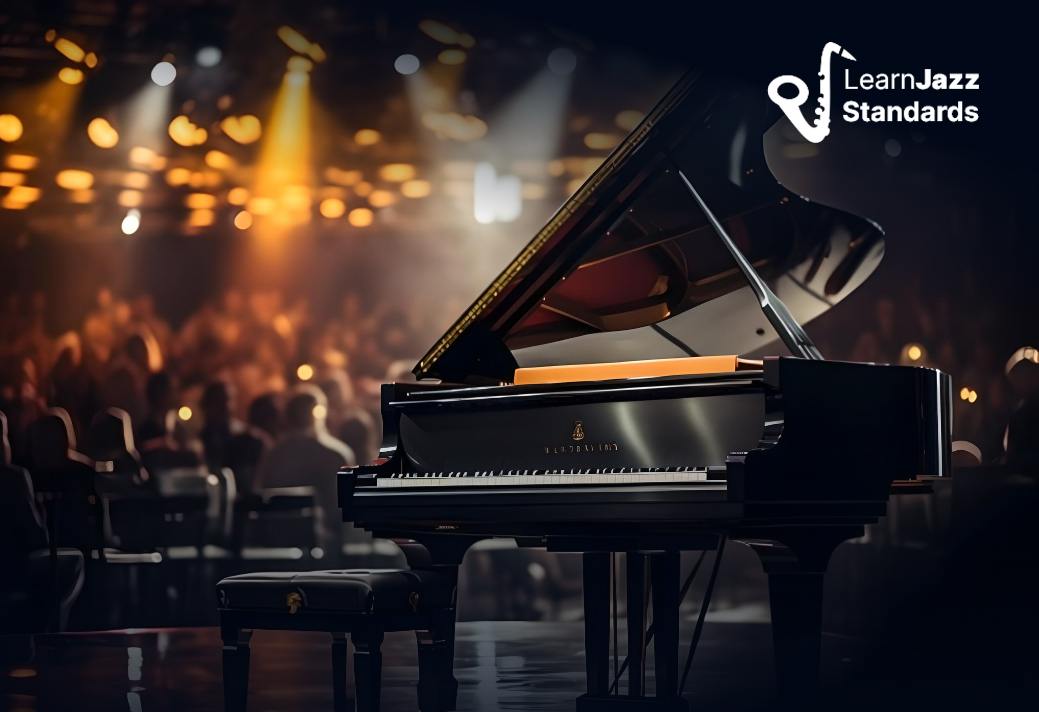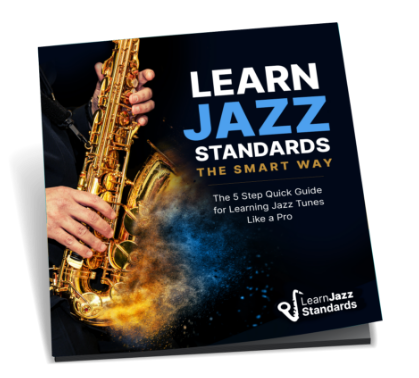Anyone who has played jazz or leafed through a jazz fakebook or “real book” probably has noticed that dominant seventh chords are some of the most common chords musicians encounter in jazz standards. But not all dominant seventh chords have the same upper structures or function.
This is vital to understand because the implications of what a jazz musician will hear and play over a dominant seventh chord vary widely. The melodies we play over dominant seventh chords and the scales they derive from or imply depend on both the specific type and function of the chord in its given context.
So in this post, let’s break down three of the most common varieties or “classes” of dominant seventh chords that frequently appear in jazz standards. We will also look at some of the different scale options suggested by each of these different “flavors” of dominant seventh chords.
Knowing the strongest scale options implied by the different types of dominant seventh chords can equip you with tools which will help you generate musical vocabulary and inspire your fingers, ears, and mind as you construct melodies while improvising.
Quick Review:
What is a Dominant Seventh Chord? How is a Dominant Seventh Chord Theoretically Derived?
This is likely review for most jazz musicians, but it’s always helpful to make sure we have our basics covered before moving on so we’re all on the same page with the meanings and usages of the specific terms I’ll use in this post. We’ll look at the chords from a few different perspectives, and hopefully one of these methods will resonate with the way you hear and think about these chords.
A basic dominant seventh chord (with no extensions – i.e. no 9ths, 11ths, or 13ths) can be thought of a few different ways:
1. In terms of tonality
It’s the chord you get if you build a diatonic seventh chord starting from the 5th note of the major mode.
The name “dominant” comes from classical music theory. In the classical world, the chord built from the root or the 1st note of the major scale is referred to as the “tonic” chord – the “I” chord. The chord built from the 5th scale degree of the major mode is called the “dominant” – the V chord (I’ve heard it said that it’s called the “dominant” chord because it’s the second most common chord in tonal music after the I chord).
So, for example, in the key of C major, the 5th scale degree – the dominant – is G. If you stack diatonic 3rds (meaning notes derived from the key of C major) on top of G to build a seventh chord, you end up with G7 (G, B, D, F natural).
2. In terms of a triad + a lowered seventh/b7
A dominant seventh chord is a major triad with an added lowered seventh (a b7) above the root of the chord.
Note: the “lowered” seventh is in comparison to a “major” or “natural” seventh. For example, the “natural” or “major” seventh above G is F#, so F natural is the lowered or b7 – so, with this method, you start with a G major triad (G, B, D) and add a b7 – F natural.
3. In terms of interval relationships
A dominant seventh chord can be defined purely in terms of stacked thirds. You start with the chord in root position – with the root of the chord as the bass note/lowest note, and stack thirds – first a major third, followed by two minor thirds.
Extended Dominant Seventh Chords in Jazz
In practice, in jazz music most dominant seventh chords do appear with or imply specific chordal extensions. So we need a definition of a dominant seventh chord that accounts for this fact and for the variance in the extensions of dominant seventh chords.
In the most generic terms, a dominant seventh chord, regardless of its extensions, can be defined as:
- Any chord with a natural (or “major”) 3rd and a lowered seventh (or “flatted 7th” or “b7”) above the root of the chord (most frequently the root of the chord will also be the bass note – the lowest sounding pitch in the chord, otherwise you arguably have a different quality of chord, with a few rare exceptions, such as in the case of a rootless piano voicing in which the ear fills in the missing root as an imaginary bass note because of the strong conventions and traditions of jazz harmony).
Here is diatonic dominant seventh chord with its complete unaltered extensions:
A basic 7th chord includes the root, 3rd, 5th, and 7th, but even the most basic modern jazz voicings often include 9ths, 11ths, and/or 13ths in most chords. Here are some diatonic extended dominant seventh chords:
Early jazz musicians and pre-swing era players such as “Jelly Roll” Morton and Bix Beiderbecke were already exploring more colorful harmonies with extended chords, but more complex jazz harmony really took off by the time composers such as Duke Ellington came along in the big band era.
As jazz’s harmonic vocabulary continued to expand and develop in the late swing era (roughly in the late 1930s), jazz musicians who spearheaded the movement we now call bebop began exploiting and altering the more “colorful” extensions of chords, especially 9ths and 13ths. Bebop musicians especially famously began exploiting and altering the extensions of chords in jazz harmony.
One of the two most common types of alterations to upper extensions involves only raising the 11th to get a dominant 7(#11) chord.
This is a harmonic maneuver which probably came from the influence of French Impressionistic composers such as Claude Debussy had on jazz musicians (for just one example, listen to Debussy’s Images and note the harmonic similarities between his writing and the piano music of Bix Beiderbecke and Thelonious Monk).
A second way to think of this chord is to think of the fully voiced out chord built from the 4th scale degree of the melodic minor scale (corresponding to the Mixolydian #4 or “Lydian Dominant” mode derived from the melodic minor mode system).
A third is to imagine this chord is as a slash chord or a polychord – it’s essentially an A major triad on top of a basic G7 chord. Here are some dominant 7(#11) chords notated:
If music theory has always seemed confusing to you and you wish someone would make it feel simple, our free guide will help you unlock jazz theory secrets.BEFORE YOU CONTINUE...

The other alterations involve using some combination of lowered and/or raised 9ths, a raised 11th and/or a lowered or natural 13th. Here are a few possibilities with specific chord voicings.
Tonality and the Dominant Seventh Chord
It’s important to note that there is a tritone between the major 3rd and flatted 7th of a dominant seventh chord. This interval relationship helps define the quality of the chord, and it is traditionally viewed as creating tension according to classical music’s theoretical conventions.
This tension is what helps create and define tonality, since the resolution of the tritone during a V7-I harmonic progression is what creates the sense of gravity, inevitably, and “homecoming” (i.e. tension and release) of a V7-I chord progression.
For tonality to be functional melodically and harmonically, you have to have a leading tone as the 7th scale degree (in other words, the 7th note of the scale has to be a major 7th above the root, or a half-step below the tonic – however, you want to visualize it). This is because, in the briefest and simplest terms possible, tonality is essentially defined by the V7-I cadential relationship, which lives and dies on the resolution of the “tension” inherent in the tritone.
The tritone exists between the 3rd and 7th of the V7 chord (think B and F for G7 in the key of C major). The 7th of the V7 chord (the 4th degree of the tonic I chord) resolves down ½ step to the 3rd of the tonic I chord and the 3rd of the V7 chord (the 7th of the tonic I chord) resolves up ½ step to the tonic (root).
The complicated thing about jazz harmony is that some of jazz’s harmonic vocabulary is borrowed from or influenced by classical music, and some of it directly defies classical music’s conventions.
Sometimes, we see V7-I chord progressions in tonal contexts in jazz, as is often the case in II-V-I progressions in Great American Songbook Standards, for example. Other times, we see dominant seventh chords that do not resolve V7-I in tonal contexts.
For example, many of Thelonious Monk’s compositions feature dominant seventh chords that do not resolve with the root moving up a perfect 4th or down a perfect 5th (for a just a few examples, see his compositions “Ask Me Now,” “Well You Needn’t,” and “I Mean You”).
So our task as jazz musicians is to identify what type of dominant seventh we’re dealing with and where it’s resolving, because these facts will influence the function of the chord and therefore affect how we approach improvising over it.
The 3 Most Common Flavors of Dominant Seventh Chords
Now that we have all of that background information covered, let’s break these various types of dominant seventh chords into three major categories or “flavors” based on their function:
1. Fully diatonic seventh chords with no alterations (regardless of where they resolve)
-
If there are no alterations, the strongest option is to use the diatonic (Mixolydian) mode. This is especially the case for modal dominant chords and especially dominant seventh chords with a suspended 4th (for example G7sus4) which are generally diatonic in their implication and often appear in modal jazz contexts.
-
However, if it is part of a chord progression that is resolving V7-I, you can also use the dominant seventh bebop scale.
2. Partially altered seventh chords that don’t resolve V7-I (i.e. with the root movement up a 4th or down a 5th)
-
The most common example is the ubiquitous dominant seventh #11 chord – use the 4th mode of melodic minor – Mixolydian #4 or “Lydian Dominant.” Note that you can also often get away with playing the whole tone scale (all whole steps built from the root) over this chord because of the strong pair of tritones created between the 3rd and 7th and between the root and #11 (or #4 if you’re thinking in terms of the scale). This is especially true in the case of dominant seventh #5 chords, which are also sometimes used for dominant seventh chords that don’t resolve V7-I.
3. Altered dominant chords that resolve V7-I
You basically have a handful of scale choices, and the scale choice will depend on a combination of the specific alterations indicated by the chord symbol and/or what the melody of the song suggests, if you want to stick close to the original suggested harmony of the composition. Here are your scale options:
-
The altered scale (the 7th mode of melodic minor – so C# melodic minor played from C) – especially when you have a b13 and an altered 9th
-
“Diminished dominant” – or the diminished scale starting with a half step – especially when you have a natural 13 and #11 with an altered 9th
-
Mixolydian b6 (the 5th mode of melodic minor – also called “Aeolian natural 3”) – especially when you want a b13 but a natural 9, 5, and 4.
-
Mixolydian b2 (the 5th mode of harmonic major) – especially when you have a b9 but a natural 13, 5, and 4.
-
Phrygian natural 3 (the 5th mode of harmonic minor) – especially when you have a b9 and b13 but a natural 5 and 4.
Here are all the scales I’ve discussed notated:
And here are additional scale choice options and my suggestions for voicing out dominant 7th chords on a chordal instrument:
-
If a chord symbol just says “C7” for example, adding a 9th or a 13th is almost always acceptable.
-
Generally, jazz musicians don’t alter dominant 7th chords unless they are resolving in a V-I bass motion (such as C7 for Fmaj.7 or C7 to F-7), in which case it’s usually acceptable to alter a dominant 7th even if there are no alterations indicated on the page.
-
If it says “C7(#11)” this almost never means C7alt. (which would be the 7th mode of
melodic minor – so C# melodic minor played from C). It almost always implies G melodic minor played from C (the 4th mode of melodic minor). Dominant 7(#11) chords are less likely to resolve V-I, as opposed to 7(b9) chords which almost always resolve V-I.
-
If it’s a dominant 7th in a modal context, and especially if it’s a 7(sus4), it strongly implies no alterations, and using the Mixolydian mode is most likely most appropriate (also, all diatonic extensions are usually acceptable in the case of a modal dominant 7th chord not resolving V-I). But of course, in practice, improvisers can always alter chords on the fly as long as everyone is listening to each other and they are flexible in their approach and willing to follow each other harmonically.
-
7(sus4) chords can come in many forms and different situations imply different corresponding scale choices. One thing to watch out for is the fact that a 7(sus4) often doesn’t have a 3rd in the voicing (though usually a natural 13th is present by default), and so in some situations, a natural or a flatted 3rd could work while improvising over this chord. So actually Dorian or Mixolydian usually work over 7(sus4) chords, unless it’s a:
-
7(sus4,b9,b13) which strongly implies a Phrygian sound, or perhaps Phrygian natural 3 (the 5th mode of harmonic minor)
-
Or a 7(sus4, b13) which might imply Mixolydian b6 (the 5th mode of melodic minor – also called “Aeolian natural 3”)
-
Or 13(sus4,b9) which implies Mixolydian b2 (the 5th mode of harmonic major)
-
Dominant 7(#5) could imply 7(alt.) [Note: maybe it actually means “7(b13)” in which case altered dominant or Mixolydian b6 are probably most appropriate], but in some cases it could also imply the whole-tone scale sound, so as always, the melody of the song might suggest one option more strongly over the other, but ultimately improvisers and comping instruments must agree in the moment by listening to each other and trying to settle on an option that fits what’s happening musically.
-
For 7(b9) chords: “7(b9)” is the most common and basic generic altered dominant chord symbol. Whether it’s got a b13 or a natural 13 is up to the interpretation of the improviser and the comping instruments unless it’s specified in the chord symbol or in the melody of the song itself [and even if a 13th is specified in the melody of a song, you can vary the 13th you choose to play over 7(b9) chords when comping during improvised solos – there is nothing stopping you from varying it as long as everyone does it together].
This is an important distinction because the quality of the 13th might suggest a different scale that fits best with it: dominant 7(b9, b13) strongly implies the altered scale [the 7th mode of melodic minor – so C# melodic minor played from C for C7(b9,b13)], whereas 7(b9, 13) with a natural 13 more strongly implies the diminished scale starting with a half step (or perhaps even Mixolydian b2). So when you’re comping a tune and the quality of the 13th of a 7(b9) chord is not super clear to begin with, I would err on the side of leaving out the 13th from your voicings altogether so that the improviser can make the scale choices they want without potentially clashing with the chordal accompaniment.
If you happen to hear which option the improviser is using, you can of course then go to a voicing which supports that option. And of course vice versa, if a chordal instrument does play a 13th in the voicing, the improviser can pick the scale that fits the voicing best if the improviser’s is listening carefully and has the ability to distinguish between the various upper structure options for 7(b9) chords.


